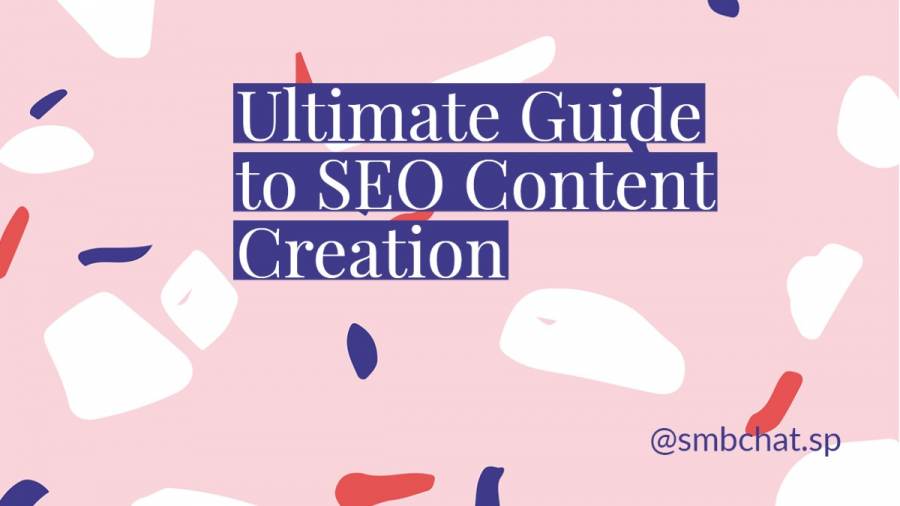The Ultimate Guide to SEO Content Creation
Wait, how old is Google again?
100 years?
50 maybe?
You'd be surprised to know that the world's 8th wonder is a mere 23 years old.
I'm no fortune teller, but I can predict your next question…
"Did you just call Google the 8th wonder of the world? You must be kidding, right?"
I'm definitely not kidding.
What else would you call a search engine that:
- Employs more than 100,000 people
- Makes more than $100 Billion a year on advertising
- Currently valued at a staggering $858 Billion
- Owns over 90% of the world's search market
- Runs over 2 Trillion (Yup, that's trillion with a capital "T") searches per year
Should I continue?
Google is, well…Google. It's head and shoulders above all other search engines, so it's understandable why its ranking factors are ever-changing.
To rank #1 on Google in this day and age, you must take content creation seriously. You must create content that both Google and your target audience will love—and you must do it often.
Look, I'm not here to give you the "cold fuzzies" or trash your existing content strategy. I'm just saying you can do better. And by better, I mean you're well capable of crafting content that ranks top in organic search and wows your audience at the same.
You can do this.
Not by wishful thinking.
Not even by appeasing the Google gods.
But by reading this blog to the very end.
Is your coffee cup filled to the brim and your feet kicked up? Alright, let's do this thing!
Treading the Murky Waters of Search Engine Optimization: What Exactly Is SEO Content?
We know. You're one of the best content creators in the whole of the Southwest, your written English is next to impeccable, and your ability to utilize relevant keywords is unquestionably good.
First of all, congratulations. Second, best believe SEO content is not just about language mastery and sprinkling in some a target word here and another one there.
SEO content has greatly evolved over the past couple of years. As we speak, Google recognizes "SEO content" as one that pleases humans and itself in equal measure.
In other words, you can only claim to have written SEO-focused piece of content if:
- It delivers the right dose of value to your target audience
- It's well-optimized for search engines
Let me guess. This SEO content definition almost made you question your status as a top-notch content creator.
No need to freak out, though.
Take a deep breath.
Then exhale. Slowly. A bit slower.
There, there.
In the subsequent sections, I'm going to show you how to write high-quality content for SEO.
But before that, let's explore a few types of SEO content:
- Ultimate guides: This is a type of long-form content that strips down a topic to its bare essentials. If you are writing an ultimate guide, let it be hard to beat in terms of depth and value.
- Product pages: A product page is to a content marketing strategy as a racquet is to a tennis player. It does just one job: help your customers decide what to buy.
- Blog posts: If you're looking to create a regular stream of high-quality long-form content, blog posts are your best bet.
- Lists: No type of content can beat lists in terms of the number of clicks it attracts. And, of course, a list-based piece of content is only half as good as the title on it.
- Video content: In case you didn’t know, video content gets 1,200 more shares than text and images combined. It attract more visitors too. So if you're looking to scoop that coveted #1 spot on Google for a competitive keyword, you might want to create visual content instead of a blog article.
- Infographics: Although not quite as readable to search engines as text, infographics can rake in a ton of views and links if optimized correctly.
- Glossaries: Admit it. You use Google to look up terms more than you use your dictionary. And that's totally OK. However, did you know that a well-thought-out, industry-specific glossary is well capable of capturing some traffic?
My good friend Ian is a big fan of content marketing. But he's a skeptical fellow as well, so he's always insisting that content marketers shape up or be shaped out.
My answer has always been: "I'll one day put together a starter pack for writing impeccable SEO content so even beginner content strategists can benefit."
Well, here we are. (Cheers, Ian)
SEO Content Creation Made Easy: 9 Tips To Take Your SEO Content From Mediocre to Google's Favorite
#1: If You're Not Focusing on The User Experience, You're Chasing Shadows
You must be living under a rock if you haven't heard about BERT yet.
BERT is an AI-powered search algorithm that processes words entered into Google in relation to all the words in the phrase, rather than one-by-one in order.
The AI is then applied to both search engine rankings and featured snippet results so that it can find results more accurately for users. And yes, it can perfectly understand the context that prepositions like "for" and "to" provide
to a keyword phrase.
Incorporating BERT into your content strategy will not only help you avoid keyword stuffing, but also ensure your content responds to user intent. The days of fluffing around keywords are long gone.
I'm not implying that you rid your content of all relevant keywords. No, not at all. I'm only saying that you use them sparingly. Gear your SEO strategy more towards intent research (more on this later), and less towards keyword research.
#2: Crafting High-Quality Content Should Be a No-Brainer
Nowadays, users are craving insightful, evergreen content.
They are yearning for pieces of content that speak to their pain points, purge their souls, and compensate them for their time. Anything less is a slap on their faces.
If your content is subpar, outdated, or otherwise clunky, you're walking a tight rope. You're basically saying: "Me first, users later." And that's a horrible approach to SEO content creation.
It's OK to admit that writing high-quality content is not your forte anymore. That's why top-notch copywriters exist, after all—to craft content so good that it blows your business goals out of the park. And for a cheap too.
The best bit about the best copywriters (like me, wink)? They are keen to learn the nuts and bolts of SEO.
Here are five questions to ask yourself as you craft your SEO content:
- Who is your target audience, and what makes them lose sleep at night?
- What specific problems do they aim to solve?
- Can you actually solve their problems?
- What kind of experience do you want them to walk away with?
- Is there a way to use valuable content to alleviate their pain points?
#3: SERP SEO Is the Name of the Game
You've probably heard of SERP SEO. It's every content marketer's kryptonite and should probably be done away with by tomorrow.
The bad news is, SERP SEO is here to stay.
The good news? It's about to become a tad bit easier courtesy of this comprehensive guide.
For those who're not privy to SERP SEO yet, it's basically the practice of optimizing content for brand visibility.
We all dread zero clicks, right? To make sure that never happens, you'll need to come up with clever metadata to reveal in rich snippets that can attract visitors to your website.
Other than snippet optimization, here are more tactics to improve your website's visibility:
- Create more pages: Each blog post is an opportunity to get noticed on Google.
- Add your website to online directories: Facebook, LinkedIn, Yelp, Angieslist, Google My Business, and Yellowpages.com are all avenues that can get your website noticed off Google.
- Get verified by Google: If you want Google to crawl your pages more efficiently, submit your business to Google Maps via Google My Business.
- Use compelling titles: Aim for clear and captivating titles, not desperate ones. For example, a title like "The Most In-Depth SEO Content Creation Guide Ever Written" sounds better than "How to Write SEO Content."
- Make the most of influencers: Look for bloggers who've already attracted a huge audience in your niche and ask them for a collaboration.
- Run a Google Ads campaign: Google ads cost money, yes. But they also have a high click-through rate. If you have the big bucks to spend, Google ads are certainly worth the plunge.
#4: Take Your Keyword Research Game a Notch Higher
While it's true that keywords are dwindling in importance, they can still help your content rank high on search engines if researched well.
How do you find a good target keyword? For starters, use a free keyword research tool like Keyword Planner or Google Search Console.
However, if you want to find meatier primary keywords, paid SEO tools like KWFinder and SEMrush are worth the punch. They double up as top-notch content creation tools as well.
With that being said, long-tail keywords with low competition and high search volume are a sure-fire ticket to Google's high table. Just make sure the long-tail keywords you pick are actually relevant to your business, product, or service.
If you are just starting out, competitive primary keywords are a no-go zone. Pursue lower-competition keywords until your business finds its footing.
#5: Double Down on Search Intent
Like I mentioned earlier, Google rates search intent highest among all its ranking factors.
The content format you choose, the message you portray, and the call-to-action you leave should depend on search intent for a keyword.
In general, search intent can be broken down into four distinct types:
- Informational: the searcher is looking for specific info on a topic. The queries will include 'why do,' 'what is, 'how to,' 'where is, and so forth.
- Commercial: the searcher is considering a buy and wants to sift through some options
- Transactional: the searcher is sold on purchasing something
- Navigational: the searcher is looking for a specific site or webpage (think of your Grandma searching Google for "Facebook" rather than just going to Facebook.com)
As a practical example, take a look at these search queries:
- How to use my IPhone: This query has informational intent
- New IPhone Waymart: The search intent for this query is geared toward transactional and navigational. They're interested in knowing the Waymart page for this page, or they are ready to add the item to their cart.
- New IPhone deals: This is transactional search intent
Optimizing for different intents is not the stuff of professors. It's actually as easy as A-B-C. Here is how you can do it:
- Navigational: These are easy pickings, but they still need to be picked. For starters, have landing pages for all your offerings. Then optimize these pages using brand and product names in HTML headers, title tags, and meta descriptions.
- Informational: Incorporate full user questions (as they appear on Google) into your on-page content. That is, HTML header tags, meta descriptions, and page titles.
- Transactional: Make it clear how the user can convert and what the conversion will mean for them. As such, your transactional landing page should have a clear CTA and a clear, crispy design.
- Commercial: If you offer a free version to your offerings, create pages to target these queries. Curate a list of free resources.
Still trying to wrap your head around the SEO benefits of search intent?
OK, here you go:
- More page views
- Reduced bounce rates
- Your blog post can be selected for Google's featured snippets. That means it'll rank in position 0 above the first search result. How cool is that?
- Wider audience reach
#6: Strive for Uniqueness
When you first started your website, you were able to churn out unique content on a regular basis. It was an easy job.
A few months in, and your hands were full with other content marketing tasks. You simply couldn't keep up.
Before you realized it, you were "stealing" a few words from your competitors and mixing them up in order to pad your word count.
Heads up: You're no longer in Google's good graces.
While Google doesn't impose a penalty for duplicate content, it does filter identical content. That means the search engine will be forced to choose which of the identical pages it should rank higher.
Woe unto you if it bypasses your page. To save yourself all that hassle, why don't you create original content from the word go?
#7: Think of Your Content Like a Construction Site
Readability is a major factor in the content creation process.
Your SEO copy should contain ideas that are forged together with clarity, coherency, and authority.
Picture yourself as a builder on a construction site.
The introduction of your article is the foundation of your blog content. Make it so strong that it can support the next layer of construction.
As you continue to build up towards the conclusion, each point should serve as a framework that holds up the overall structure.
Further strengthen the construction of your SEO content by:
- Starting with the most basic concepts and building up to in-depth points
- Using transitional phrases to help you move seamlessly between sections
- Connecting separate thoughts by showing putting them into context and showing how they're related
- Publishing only fresh content
#8: Put More Effort Into Your Link Building Strategy
importance of well-optimized internal and external links can't be further overstated. SEO content with carefully planted hyperlinks will always have a lower bounce rate and a higher conversion rate than one without.
There are basically three types of links:
- Internal links are links between the pages within your website
- Inbound links are links that come from other websites or a different domain name
- Outbound links are those links on your website that link out to websites with a different domain name
These are indispensable since they all contribute to creating a strong link-building strategy, but you must be careful. Links to non-reputable sites or using out-of-date information will only hurt instead of help.
For every 1000 words of SEO content, include about two inbound links, three internal links, and six external links. You can always add more links depending on the content itself.
#9: Optimize for Mobile Device
Newsflash: 55% of all worldwide online traffic in 2020 came from mobile. And that figure is expected to hit a staggering 73% by 2025.
If you're not optimizing your content for mobile, you're already late. OK, maybe a tiny bit late since these tips will bring you up to speed:
- Test your site using Google's mobile-friendly tool
- Use a mobile-friendly WordPress theme
- Have a reliable web host
- Improve your site's load times—anything more than 2 seconds is a letdown.
- Redesign your pop-ups for mobile devices
- Enable accelerated mobile pages (AMP)
- If push comes to shove, create a mobile app
Too Much On Your Plate? An Expert SEO Copywriter Can Help
Content marketing is ridiculously stacked and insanely fast-changing. If we're being honest, you need a hand to help with all the heavy lifting, and a copywriter is undoubtedly your best bet.
Here at Zoey Writers, we’ve spent years working with business owners, helping them fine-tune their content marketing strategies thorough super content writing services and bring their content ideas to life. You could be next.
The best time to hire us was yesterday; the second-best time is now.
















